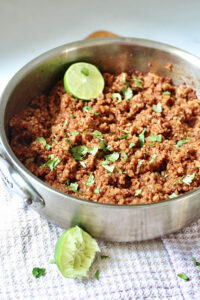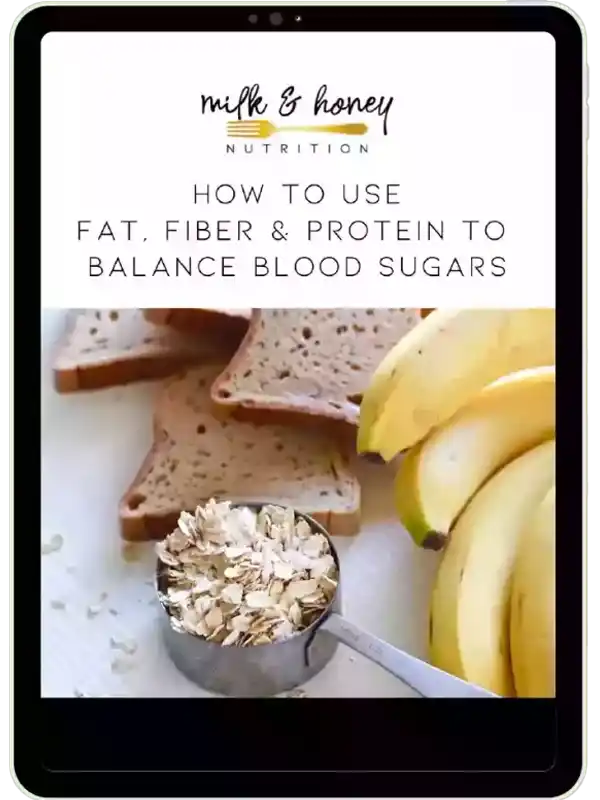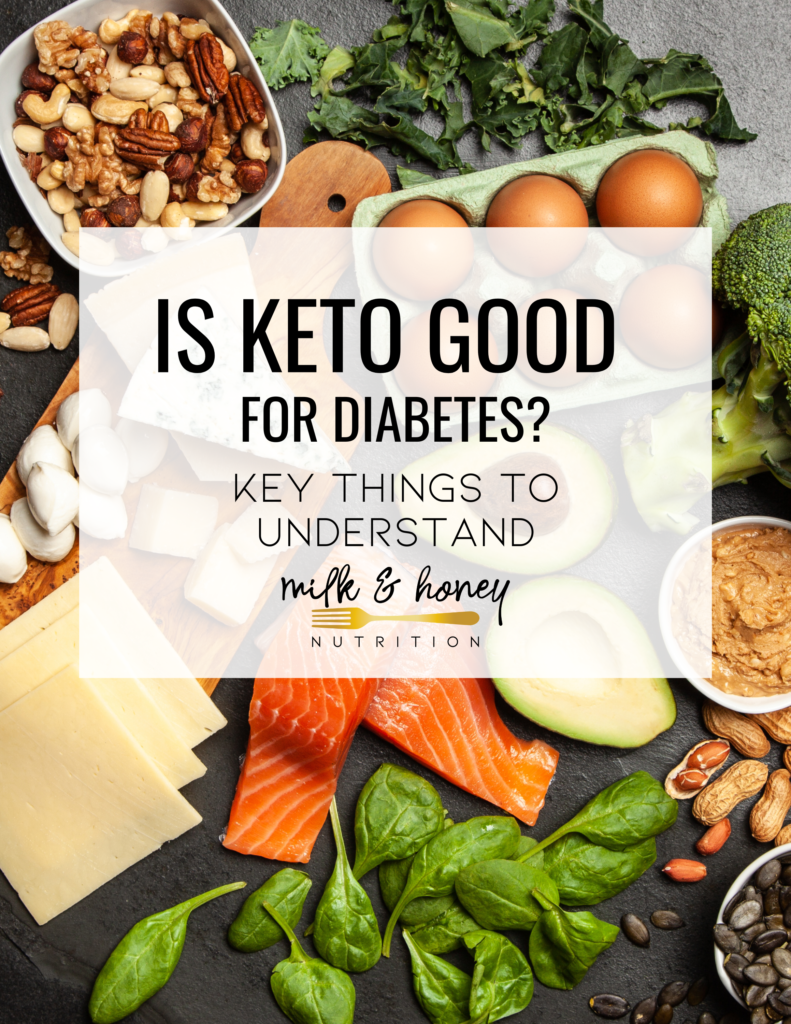
In this article, we’ll discuss what the keto diet is, is keto good for diabetes, and keto-friendly foods.
The keto diet has been gaining popularity for weight loss, but is keto good for diabetes? There’s a lot of confusion and false information out there about the keto diet, so let’s start unpacking.
What is the keto diet?
The keto diet (keto) is a high-fat (60%), moderate-protein (30%), and low-carb (10%) diet. Most people on keto diets eat less than 50 grams of carbs per day. On the other hand, the ADA (American Diabetes Association) doesn’t provide a set number restriction for carbs, fat, and protein. Instead, they recommend using the “Diabetes Plate Method.” This method suggests making your plate ½ non-starchy vegetables (ex. lettuce, zucchini, broccoli), ¼ starch (ex. rice, pasta, bread), and ¼ protein (ex. chicken, steak, tofu).
Our bodies prefer using carbs for energy. When the body is starving, it’ll switch to plan B: using fat stores for energy. The keto diet tricks our body into entering a starving state, without actually starving. It enters “ketosis” and starts to use fat for energy instead of carbs (more on this later). Our bodies break down fat into ketones, which our brain uses instead of glucose for energy.
Not a lot of people know this, but the ketogenic diet (keto) was created to treat children with epilepsy. Now, it’s become more popular for weight loss purposes and blood sugar management.
Since the keto diet focuses on the macronutrient ratio and not specific foods, it can look different depending on who you talk to.
Some people will follow a “dirty” keto diet, which includes high saturated fat foods like cheese, bacon, butter, processed foods, and artificial sweeteners. Unfortunately, it doesn’t always include fresh fruits or vegetables.
When following the keto diet, it’s still important to include foods from every food group to get the nutrients your body needs!
Keto for diabetes
Since keto is a low-carb diet, it seems like it would be good for diabetes… right? Unfortunately, the answer isn’t that simple.
Some studies have shown a keto diet has a positive effect on diabetes. This includes lower A1C and reduced insulin doses. However, there is still not enough research to know the long-term effects on the body.
Depending on your age, life stage, the type of diabetes, and other factors, keto may not be the best diet to manage your diabetes.
History of keto and diabetes
Before the days of insulin and diabetes medicine, diet was one of the only ways to manage diabetes. Some doctors began to realize that food affected people’s signs and symptoms of diabetes. Some even recommended that patients fast or eat a very-low calorie diet. However, starvation as a way to treat a disease wasn’t very well-received.
When carbs were found to play a role in diabetes, very low-carb or strict carb-free diets were used. This diet later included high-fat along with the low-carb recommendation. But this diet wasn’t named the ketogenic diet until its use to treat epilepsy in the 1920s.
Is keto safe for diabetes?
It’s possible to follow the keto diet if you have diabetes, but it requires extra care and supervision. The long term effects are not fully understood, so make sure to talk with your diabetes care team about your eating pattern and symptoms you may feel. This is especially important if you are taking insulin, since the low-carb diet and insulin combined may cause blood sugars to drop.
Keto and type 1 diabetes
It’s not 100% clear if keto is helpful for those with type 1 diabetes. One benefit of the keto diet that may help is lowering the amount of insulin you need. Before the discovery of insulin, very-low carb diets were used to manage diabetes. However, research is still limited in this area. So if you have type 1 and want to try the keto diet, make sure you are having a discussion with your care team!
Keto and type 2 diabetes
The keto diet is a popular diet for many people living with type 2 diabetes. Not only does the keto diet lower the amount of carbs eaten, but it can also lead to weight loss and improved insulin sensitivity. In fact, one study found that one of the main reasons people choose to go on the keto diet is for weight loss purposes.
Is keto good for type 2 diabetes?
With all that being said, is keto good for type 2 diabetes? The answer is complicated. There are positive short-term effects of a keto diet. These include the following:
- Weight loss
- Improved lipid lab levels (cholesterol, triglycerides, etc.)
- Improved insulin sensitivity
- Less need for diabetes-related medications
But, these benefits will be the most helpful if the keto diet is followed long-term. The problem is, the keto diet isn’t easy to stick to since it is so restrictive and may be hard to keep following.
Most people are not able to follow a keto diet past one year because of how restrictive it is. This can be for many reasons such as:
- Culture
- Religion
- Economic barriers
- Personal preferences
Is keto safe for children with diabetes?
Most new cases of type 1 diabetes are found in children and teenagers. While the keto diet was developed to treat seizures in children, this diet was used only for a short time. While adults are able to follow the keto diet with little issue, it may be a problem for these growing humans! It’s important for kids to eat a good variety and amount of food so that they can grow up to be healthy adults. The keto diet may be too restrictive for kids to follow and might do more harm than good, even if they have diabetes.
What foods are included in the keto diet?
Recommended foods in the keto diet are low in carb and higher in fat. Keep in mind that even a “low carb food” can become high carb if you eat it in high enough quantities. Below is a list of nutritious foods from different food groups that are more keto-friendly:
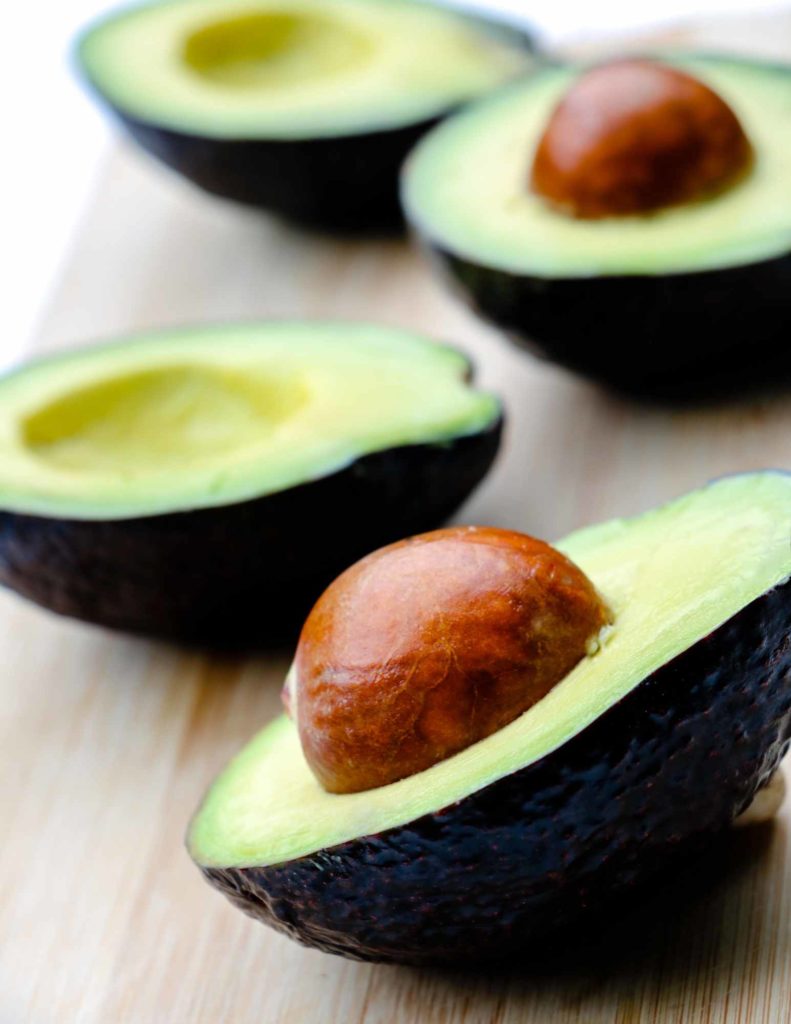
Fruits
- Avocado
- Raspberries
- Blackberries
- Tomatoes
- Coconut
- Lemon
- Lime
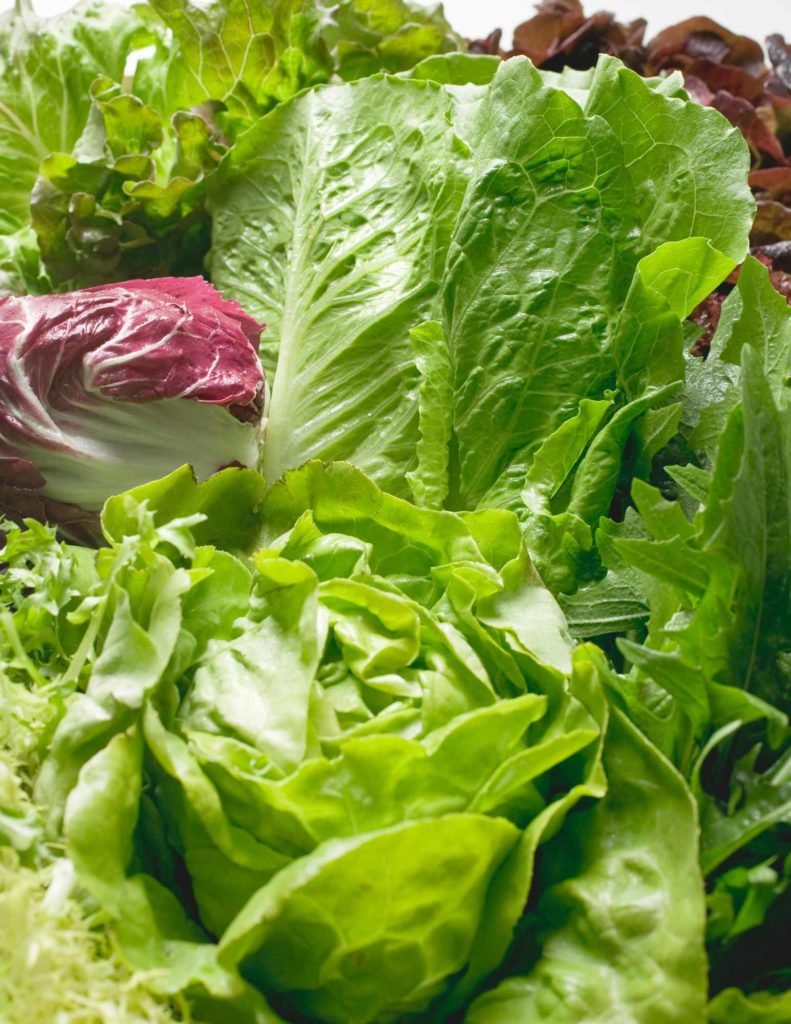
Vegetables
- Leafy greens
- Green peppers
- Summer squash (zucchini, yellow squash)
- Mushroom
- Eggplant
- Brussels sprouts
- Cauliflower
- Broccoli
- Spaghetti squash
- Jicama
- Radishes
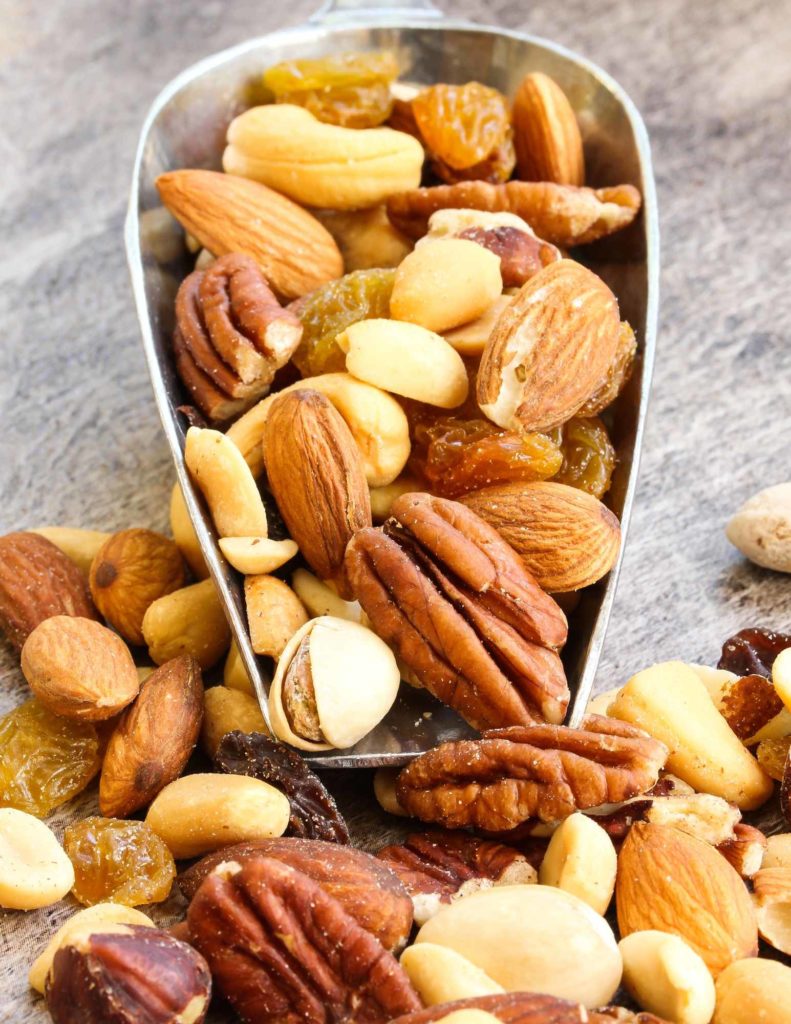
Legumes/Nuts/Seeds
- Peanuts
- Almonds
- Pecans
- Macadamia nuts
- Walnuts
- Chia seeds
- Sunflower seeds
- Flaxseeds
- Hemp seeds

Meats/Meat Alternatives/Dairy
- Fish/shellfish
- Tofu
- Seitan
- Tempeh
- Beef
- Pork
- Chicken
- Eggs
- Fermented cheeses (cheddar, brie, blue cheese, parmesan)
- Plain yogurts
- Heavy cream
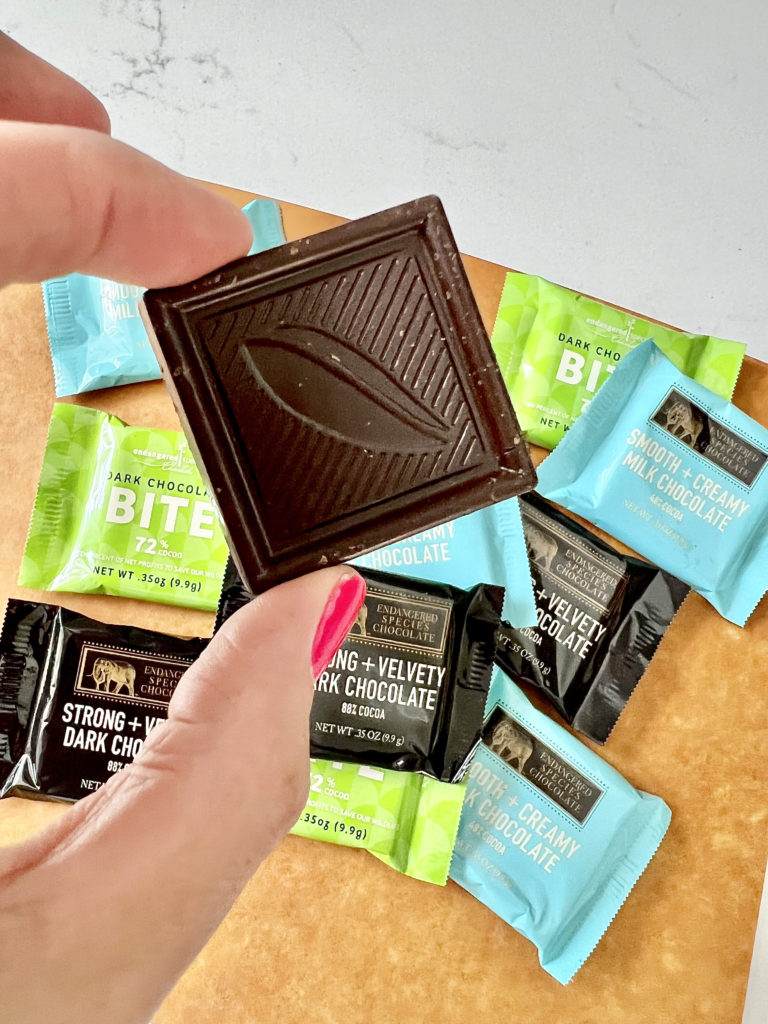
Other
- Shirataki noodles
- Dark chocolate (high percentage of cocoa)
- Ghee
- Lard
- Plant oils
What can you not eat on keto?
The keto diet doesn’t exclude specific foods. However, foods that are naturally higher in carbs may not be recommended, since you might meet your entire carb limit through just one snack or meal. Below are some higher-carb foods from different food groups to look out for!
Fruits
- Dried, frozen, and fresh fruits are mostly too high in carbs for keto
Vegetables
- Sweet squash (butternut, kabocha, acorn)
- Sweet potato
- Potato
- Carrots
- Beets
- Plantains
- Pumpkin
- Corn
- Parsnips
- Onions (in excess quantity)
Legumes
- Sweet peas
- Lentils
- Chickpeas
- Kidney beans
- Black-eyed peas
- Pinto beans
Grains
Meats/Meat Alternatives/Dairy
- Glazed hams
- Saucy meats (BBQ pulled pork, BBQ ribs, etc)
- Seasoned beef jerky
- Processed meat alternatives
- Milk (Flavored and plain milks)
- Fresh cheeses (mozzarella, cream cheese, cottage cheese)
Processed Foods
- Baked goods
- Chips and crackers
- Candies and chocolates
Drinks
- Most alcohol
- Sodas
- Smoothies
- Juices
- Lemonade
- Energy drinks
- Flavored coffees
- Sweet teas
Keto-friendly recipes
If you’re looking for some keto-friendly recipes, we do have some here on the site. Give one of these a try:

Colorful Mediterranean Omelette with Feta

Copycat Baked Starbucks Bacon Egg Bites
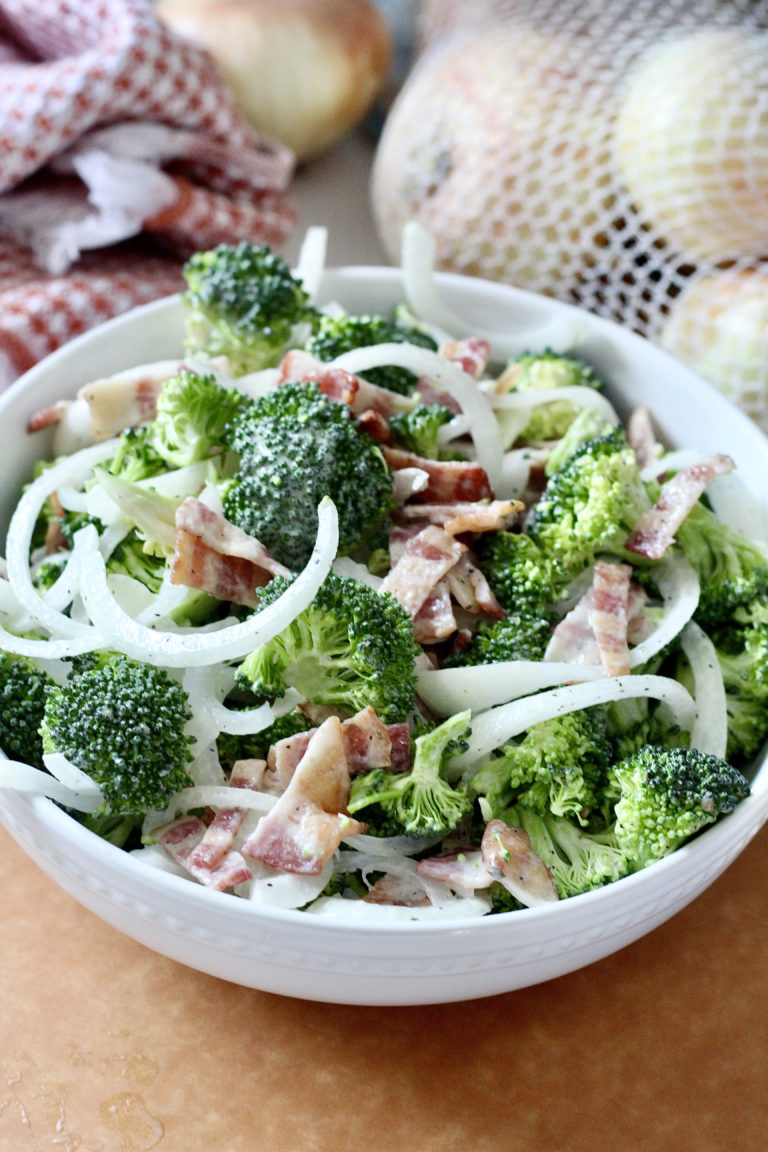
Low Carb Broccoli Ranch Salad with Bacon
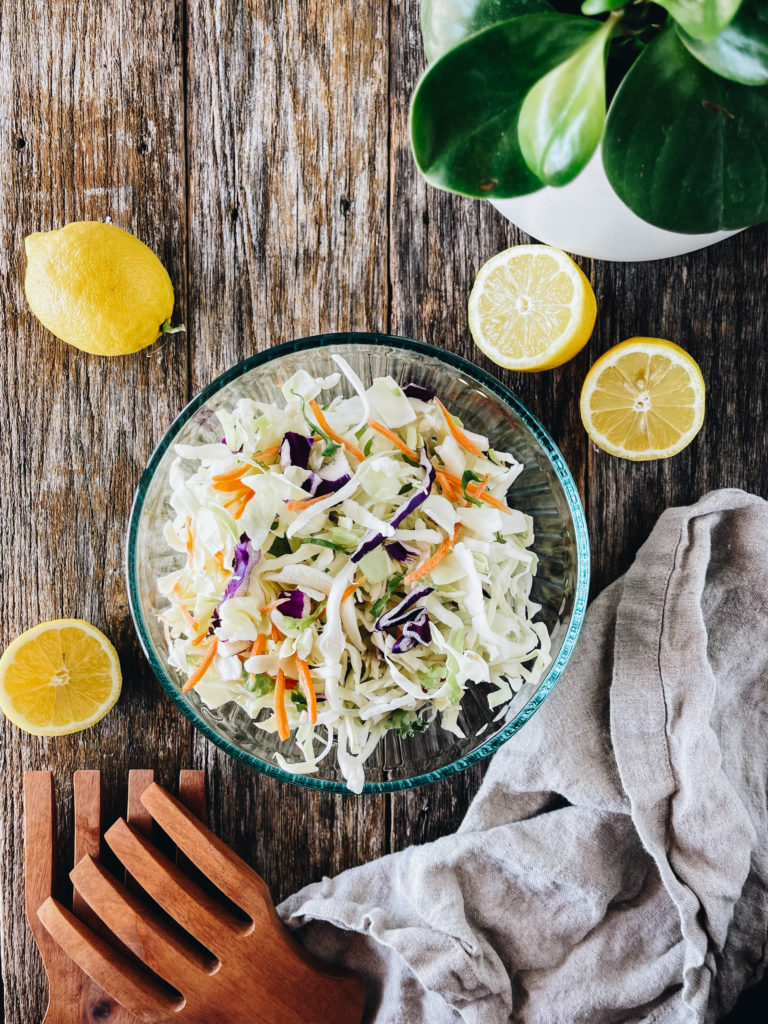
Healthy Low Carb Coleslaw (6 ingredients)
Can keto cause diabetes?
In short, no. The keto diet has not been proven to cause diabetes. One study done in mice showed insulin resistance after 3 days of a high-fat, low-carb diet. While it was true for these mice, that doesn’t mean it’s the same for people.
What is true, is that those following a keto diet may result in eating higher amounts of saturated fat and getting less fiber, vitamins, and minerals from fruits, vegetables, and whole grains. This might cause other health issues in the future, but keto doesn’t directly cause diabetes.
Can keto reverse diabetes?
Yes and no.
The keto diet can’t reverse type 1 diabetes since this is an auto-immune disease.
For type 2 diabetes, it can reverse the symptoms, but the disease itself won’t fully go away. This is called “remission.” And, while the keto diet has been shown to reverse the effects of type 2 diabetes, it may actually be the significant weight loss that can result from the keto diet that is actually lowering blood sugar levels.
Ketosis vs Ketoacidosis
Earlier I mentioned ketosis, the state our body enters when we aren’t eating enough carbs. The word sounds strangely similar to ketoacidosis, so let’s talk about the differences.
Ketosis is when the body begins to form ketones from fat for energy. This phenomenon also occurs in people with diabetes, but for a different reason. In diabetes, specifically type 1, there is no insulin at all to help use carbs for energy. So our body thinks it’s starving because it can’t use carbs and will begin to use fat at a super fast rate. A large amount of ketones are made and they are acidic in blood. This is called diabetic ketoacidosis (or DKA).
| Ketosis | Ketoacidosis | |
| Blood sugar levels | Low or Normal | High |
| Blood ketone levels | Low to moderate | High |
| Causes | High fat, low carb diet | Low insulin levels (normally type 1 diabetes) |
| Benefits | Seizure treatmentWeight loss | None |
| Symptoms | Low energy, Bad breath, Weakness, Headache | Dehydration, Extreme thirst, Confusion, Nausea, Vomiting, Abdominal pain, Rapid breathing, Extremely frequent urination, Confusion |
| Dangers | Normally, no | Yes; Can cause coma and even death |
| Treatment | None needed | Immediate treatment necessary |
Dangers of ketosis for diabetes
People without diabetes don’t need to worry about ketosis becoming dangerous. Normally, our bodies do a pretty good job at making sure ketone levels don’t go too high. However, there is a risk for those with diabetes. This is because the body isn’t able to make or use insulin like normal.
If you choose to follow a keto diet and have diabetes, it’s important to use a ketone meter to measure your ketone levels. This can help you find out whether or not you’re in ketosis or at risk for DKA. If you have diabetes and are trying to lose weight, ketones in your urine may be in the low to moderate range. If your blood sugars are within range, this most likely won’t be a risk for DKA.
Euglycemic Diabetic Ketoacidosis (DKA)
A common sign of DKA is high blood sugars. But what not everyone knows is that you can get DKA, even when your blood sugars are within range. This is called “Euglycemic DKA.” So how does this even happen? After all, if you’re hardly eating carbs, isn’t diabetes better controlled? The answer is a little complicated.
While it’s possible to manage blood sugars on the keto diet, the body will still be adjusting to the fact that their preferred energy source is gone. Usually on the keto diet, the body releases hormones that have the opposite effect as insulin. These are called “counterregulatory hormones.” These include glucagon and other stress hormones. They tell the body to use fat for energy which increases ketones.
The body has checks and balances to make sure the ketones don’t get too high by releasing insulin when needed. Insulin and glucagon are usually good at balancing each other out in people without diabetes. And while the keto diet causes less insulin activity, it still uses insulin when needed. In type 1 diabetes (sometimes even type 2), the body isn’t able to use insulin as usual. That means ketones can get higher and higher, and eventually become ketoacidosis.
Ketogenic hypoglycemia
Ketotic, or ketogenic, hypoglycemia occurs most frequently in young children, without the presence of diabetes. It occurs when they are fasting or ill and have not consumed carbs over a long period of time. While the actual cause of ketogenic hypoglycemia isn’t fully understood in children, it is normally outgrown as they grow older.
People with diabetes following the keto diet and who are also taking insulin may also be at risk for hypoglycemia. However, this is not the same as the ketogenic hypoglycemia that occurs in healthy young children.
The best way to balance your blood sugar
At the end of the day, the best way to balance your blood sugars is what works best for you! Every person is different. We all like different foods, have different bodies, and come from different food backgrounds and cultures.
One person might do well on a keto diet and live their whole life following it. But that doesn’t mean it’s impossible to manage blood sugars if the keto diet isn’t right for you.
While the keto diet provides a limit on grams of carbs per day, my philosophy is different. Instead of a hard number, I encourage people to balance their meals with healthy fat, protein, and fiber. This provides the freedom and flexibility to enjoy your favorite foods without being restricted by a number. Remember, your food choices are yours! Do what works for your body and brings you joy.
Is keto best for me?
If you’re considering a keto diet, here are some questions you can ask yourself to figure out if it’s a good option for you:
- Are high-carb foods a staple to my culture? (example: Rice is a staple in many Asian diets)
- Will it be a challenge for me to count grams of carbs and fat in my diet?
- Is this a good diet for my current activity level? (High intensity exercises may be difficult on the keto diet)
- Will this diet be sustainable for me long term?
- Will this improve my quality of life or make it worse?
Whatever you decide to do, make sure it is done safely and that you make the best choice for you and your health. And, always consult your diabetes care team before making drastic changes to your diet.



